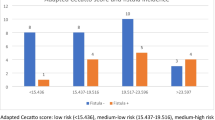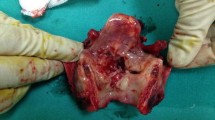Abstract
Laryngeal cancer treatment is often wrought with challenges, pharyngocutaneous fistula formation (PCF) in patients undergoing either primary or salvage laryngectomy for laryngeal and hypopharyngeal for squamous cell carcinoma is an important one. We aimed to study the factors before and at the surgery that are associated with PCF formation in a South Indian tertiary care hospital. A retrospective chart review of 127 patients who underwent total laryngectomy (TL) between May 2014 and April 2019 at our centre were done. Data was collected, including patient age and gender, comorbidities (Diabetes mellitus, COPD and hypothyroidism), smoking, tumor stage and site, prior tracheostomy, prior radiation, concurrent neck dissection and type of pharyngoplasty, Preoperative hemoglobin and albumin levels, surgical margin status and development of a PCF was also done. Further details specific to the development of a PCF were recorded for that subset of patients including the length of time to fistula, mode of closure, time of closure and modality of management. The overall incidence of PCF was 16.5% (21 of 127 patients), and the median time from TL to the diagnosis of PCF was 6 days (range, 3–20 days). The analysis was done separately for laryngectomies without any pharyngeal reconstruction (112/127 patients). In patients treated with a primary TL, the incidence of PCF was 12.20% (10 of 82) and 26.66% (8 of 30) after salvage TL. Subset analysis for type of pharyngoplasty repair showed 12% (15/127) underwent different types of vascularised/muscular flap for smaller residual pharyngeal mucosa, of which 20% (3/15) developed PCF and one patient developed haematoma needing exploration and re-suturing. The predictive factors for PCF were hypopharynx cancer (P < 0.05), surgical margin positivity (P < 0.0001), female gender (P < 0.05), absence of prior tracheostomy (P < 0.05) and tumor extension into pyriform sinus mucosa (P < 0.05). Preoperative patient factors of gender and site of primary along with histological margin positivity and extension of tumor to the pyriform sinus mucosa were significant risk factors for PCF formation. Pre-Op radiotherapy remains a strong clinical suspicion but not statistically significant.


Similar content being viewed by others
Abbreviations
- PCF:
-
Pharyngocutaneous fistula
- OR:
-
Odds Ratio
- CI:
-
Confident interval
- TL:
-
Total laryngectomy
- RT:
-
Radiation therapy
- CTRT:
-
Chemotherapy and radiation therapy
- COPD:
-
Chronic obstructive pulmonary disease
- TNM:
-
Tumor node metastasis system
- POD:
-
Postoperative day
- PO:
-
Postoperative
- SCC:
-
Squamous cell carcinoma
References
Bobdey S, Jain A, Balasubramanium G (2015) Epidemiological review of laryngeal cancer: an Indian perspective. Indian J Med Paediatr Oncol. 36:154–160. https://doi.org/10.4103/0971-5851.166721
National Cancer Registry Programme (2013) Three-Year Report of Population Based Cancer Registries 2009–2011. Indian Council of Medical Research. https://main.icmr.nic.in/sites/default/files/reports/Preliminary_Pages_Printed.pdf. Accessed 29 Feb 2020
IARC Publications—PDFs online—Cancer Epidemiology—Cancer Survival in Africa, Asia, the Caribbean and Central America—SurvCan [Internet]. [cited 2020 Feb 29]. Available http://survcan.iarc.fr/indexsurvcan1.php
Vainshtein JM, Wu VF, Spector ME, Bradford CR, Wolf GT, Worden FP (2013) Chemoselection: a paradigm for optimization of organ preservation in locally advanced larynx cancer. Expert Rev Anticancer Ther 13:1053–1064. https://doi.org/10.1586/14737140.2013.829646
Sullivan CB, Ostedgaard KL, Al-Qurayshi Z, Pagedar NA, Sperry SM (2020) Primary laryngectomy versus salvage laryngectomy: a comparison of outcomes in the chemoradiation era. The Laryngoscope. https://doi.org/10.1002/lary.28343
Goepfert RP, Hutcheson KA, Lewin JS, Desai NG, Zafereo ME, Hessel AC, Lewis CM, Weber RS, Gross ND (2017) Complications, hospital length of stay, and readmission after total laryngectomy. Cancer 123:1760–1767. https://doi.org/10.1002/cncr.30483
Galli J, De Corso E, Volante M, Almadori G, Paludetti G (2005) Postlaryngectomy pharyngocutaneous fistula: incidence, predisposing factors, and therapy. Otolaryngol Head Neck Surg 133:689–694. https://doi.org/10.1016/j.otohns.2005.07.025
Liang J-W, Li Z-D, Li S-C, Fang F-Q, Zhao Y-J, Li Y-G (2015) Pharyngocutaneous fistula after total laryngectomy: a systematic review and meta-analysis of risk factors. Auris Nasus Larynx 42:353–359. https://doi.org/10.1016/j.anl.2015.04.002
Sayles M, Grant DG (2014) Preventing pharyngo-cutaneous fistula in total laryngectomy: a systematic review and meta-analysis. Laryngoscope. 124:1150–1163. https://doi.org/10.1002/lary.24448
Boscolo-Rizzo P, De Cillis G, Marchiori C, Carpenè S, Da Mosto MC (2008) Multivariate analysis of risk factors for pharyngocutaneous fistula after total laryngectomy. Eur Arch Otorhinolaryngol 265:929–936. https://doi.org/10.1007/s00405-007-0562-z
Lebo NL, Caulley L, Alsaffar H, Corsten MJ, Johnson-Obaseki S (2017) Peri-operative factors predisposing to pharyngocutaneous fistula after total laryngectomy: analysis of a large multi-institutional patient cohort. J Otolaryngol Head Neck Surg. 46:54. https://doi.org/10.1186/s40463-017-0233-z
Wang M, Xun Y, Wang K, Lu L, Yu A, Guan B et al (2020) Risk factors of pharyngocutaneous fistula after total laryngectomy: a systematic review and meta-analysis. Eur Arch Otorhinolaryngol 277:585–599. https://doi.org/10.1007/s00405-019-05718-9
Benson EM, Hirata RM, Thompson CB, Ha PK, Fakhry C, Saunders JR et al (2015) Pharyngocutaneous fistula after total laryngectomy: a single-institution experience, 2001–2012. Am J Otolaryngol 36:24. https://doi.org/10.1016/j.amjoto.2014.08.017
White HN, Golden B, Sweeny L, Carroll WR, Magnuson JS, Rosenthal EL (2012) Assessment and incidence of salivary leak following laryngectomy. Laryngoscope 122:1796–1799. https://doi.org/10.1002/lary.23443
Ganly I, Patel S, Matsuo J, Singh B, Kraus D, Boyle J et al (2005) Postoperative complications of salvage total laryngectomy. Cancer 103:2073–2081. https://doi.org/10.1002/cncr.20974
Mimica X, Hanson M, Patel SG, McGill M, McBride S, Lee N et al (2019) Salvage surgery for recurrent larynx cancer. Head Neck 41:3906–3915. https://doi.org/10.1002/hed.25925
Patel UA, Moore BA, Wax M, Rosenthal E, Sweeny L, Militsakh ON et al (2013) Impact of pharyngeal closure technique on fistula after salvage laryngectomy. JAMA Otolaryngol Head Neck Surg. 139:1156–1162. https://doi.org/10.1001/jamaoto.2013.2761
Grau C, Johansen LV, Hansen HS, Andersen E, Godballe C, Andersen LJ et al (2003) Salvage laryngectomy and pharyngocutaneous fistulae after primary radiotherapy for head and neck cancer: a national survey from DAHANCA. Head Neck 25:711–716. https://doi.org/10.1002/hed.10237
Qureshi SS, Chaturvedi P, Pai PS, Chaukar DA, Deshpande MS, Pathak KA et al (2005) A prospective study of pharyngocutaneous fistulas following total laryngectomy. J Cancer Res Ther 1:51–56. https://doi.org/10.4103/0973-1482.16092
Hui Y, Wei WI, Yuen PW, Lam LK, Ho WK (1996) Primary closure of pharyngeal remnant after total laryngectomy and partial pharyngectomy: how much residual mucosa is sufficient? Laryngoscope. 106:490–494. https://doi.org/10.1097/00005537-199604000-00018
Sharma S, Chaukar DA, Laskar SG, Kapre N, Deshmukh A, Pai P et al (2016) Role of the pectoralis major myofascial flap in preventing pharyngocutaneous fistula following salvage laryngectomy. J Laryngol Otol 130:860–864. https://doi.org/10.1017/s0022215116008501
Basheeth N, O’Leary G, Sheahan P (2014) Pharyngocutaneous fistula after salvage laryngectomy: impact of interval between radiotherapy and surgery, and performance of bilateral neck dissection. Head Neck 36:580–584. https://doi.org/10.1002/hed.23337
Wulff NB, Kristensen CA, Andersen E, Charabi B, Sørensen CH, Homøe P (2015) Risk factors for postoperative complications after total laryngectomy following radiotherapy or chemoradiation: a 10-year retrospective longitudinal study in Eastern Denmark. Clin Otolaryngol 40:662–671. https://doi.org/10.1111/coa.12443
Nitassi S, Belayachi J, Chihab M, Rkain I, Benayad J, Benbouzid MA et al (2016) Evaluation of post laryngectomy pharyngocutaneous fistula risk factors. Iran J Otorhinolaryngol. 28:141–147 PMID: 27280101
Scotton WJ, Nixon IJ, Pezier TF, Cobb R, Joshi A, Urbano TG et al (2014) Time interval between primary radiotherapy and salvage laryngectomy: a predictor of pharyngocutaneous fistula formation. Eur Arch Otorhinolaryngol 271:2277–2283. https://doi.org/10.1007/s00405-013-2726-3
Aires FT, Dedivitis RA, de Castro MAF, Ribeiro DA, Cernea CR, Brandão LG (2012) Pharyngocutaneous fistula following total laryngectomy. Braz J Otorhinolaryngol. 78:94–98. https://doi.org/10.5935/1808-8694.20120040
Markou KD, Vlachtsis KC, Nikolaou AC, Petridis DG, Kouloulas AI, Daniilidis IC (2004) Incidence and predisposing factors of pharyngocutaneous fistula formation after total laryngectomy. Is there a relationship with tumor recurrence? Eur Arch Otorhinolaryngol 261:61–67. https://doi.org/10.1007/s00405-003-0643-6
González-Ballester D (2016) The tissue shrinkage phenomenon on surgical margins in oral and oropharyngeal squamous cell carcinoma. Plast Aesthet Res 3:150–157. https://doi.org/10.20517/2347-9264.2016.23
Upile T, Fisher C, Jerjes W, El Maaytah M, Searle A, Archer D, Michaels L, Rhys-Evans P, Hopper C, Howard D, Wright A (2007) The uncertainty of the surgical margin in the treatment of head and neck cancer. Oral Oncol 43:321–326. https://doi.org/10.1016/j.oraloncology.2006.08.002
Erdag MA, Arslanoglu S, Onal K, Songu M, Tuylu AO (2013) Pharyngocutaneous fistula following total laryngectomy: multivariate analysis of risk factors. Eur Arch Otorhinolaryngol 270:173–179. https://doi.org/10.1007/s00405-012-2111-7
Aydoğan LB, Kiroğlu M, Tuncer U, Soylu L (2003) The wound amylase concentration in the prediction of pharyngocutaneous fistula. Otolaryngol Head Neck Surg 129:414–416. https://doi.org/10.1016/S0194-59980300714-9
Patel UA, Keni SP (2009) Pectoralis myofascial flap during salvage laryngectomy prevents pharyngocutaneous fistula. Otolaryngol Head Neck Surg 141:190–195. https://doi.org/10.1016/j.otohns.2009.03.024
Author information
Authors and Affiliations
Corresponding author
Additional information
Publisher's Note
Springer Nature remains neutral with regard to jurisdictional claims in published maps and institutional affiliations.
Rights and permissions
About this article
Cite this article
Michael, R.C., Das, S., Mani, S. et al. Pharyngocutaneous Fistula Following Primary and Salvage Laryngectomy: Aetiology and Predictive Factors. Indian J Otolaryngol Head Neck Surg 74 (Suppl 2), 2139–2148 (2022). https://doi.org/10.1007/s12070-020-02046-x
Received:
Accepted:
Published:
Issue Date:
DOI: https://doi.org/10.1007/s12070-020-02046-x




